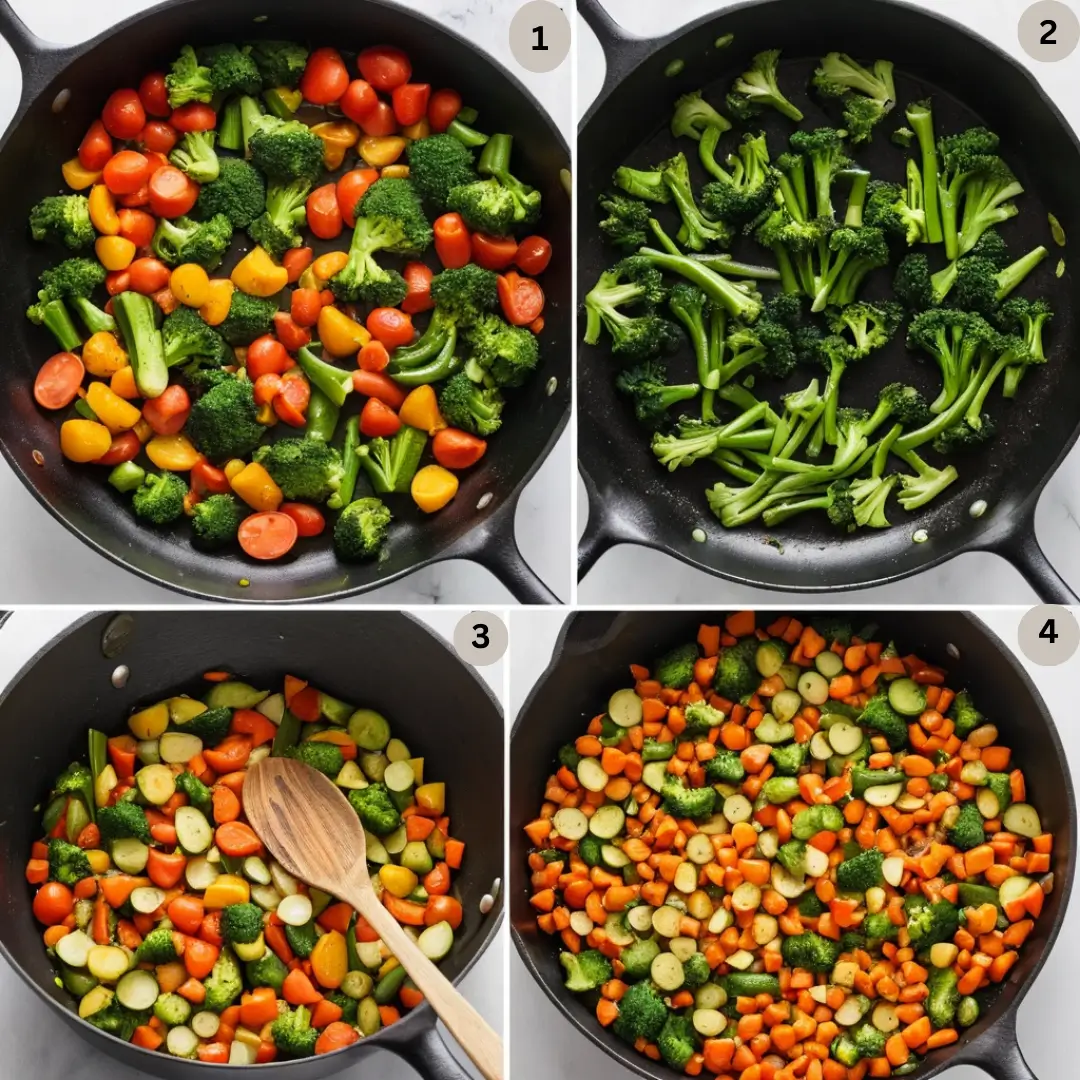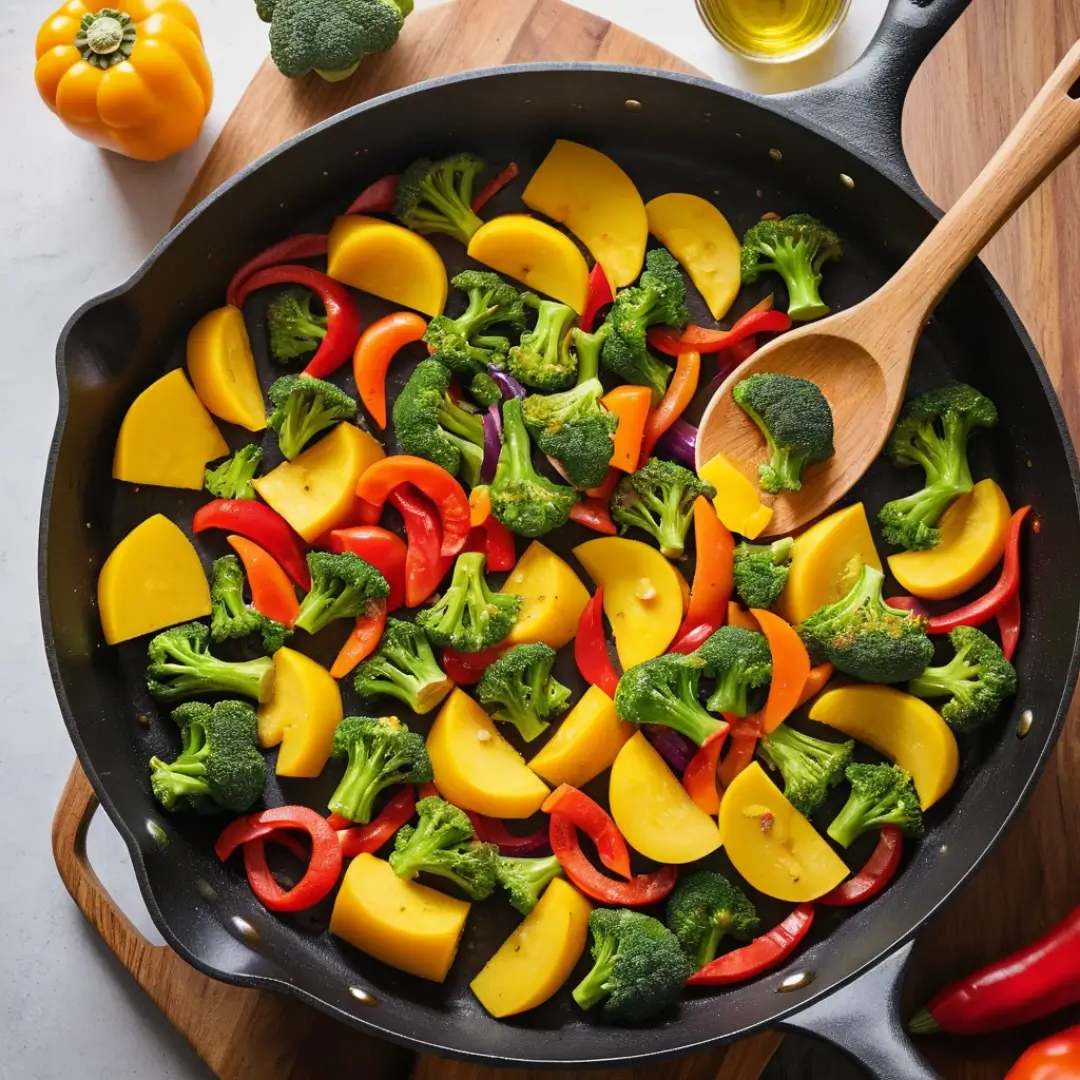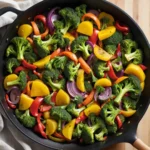The kitchen has always felt like a heartbeat to me—steady, warm, alive. Growing up, I’d perch on a worn stool in my grandmother’s tiny kitchen, watching her create magic from simple ingredients. It’s this spirit I carry into every recipe I share.
Today, I’m bringing you a comforting, vibrant dish: Sauteed Vegetables. It’s perfect for busy days when you crave something quick, healthy, and packed with love. Whether you’re meal prepping for the week or just craving a wholesome dinner, this recipe brings simplicity and heart to your table.
Why You’ll Love This Recipe
When I first started Milestone Recipes, I wanted every dish to feel like coming home. This Sauteed Vegetables recipe isn’t just about getting dinner on the table; it’s about creating a little pocket of peace in your day. It’s quick, flexible, and forgiving—just like the meals my grandmother used to make. Plus, it’s perfect for saute meal prep, making your week ahead easier and brighter.
Sauteed Vegetables Recipe
Ingredients:
1 red bell pepper, sliced
1 yellow bell pepper, sliced
1 zucchini, sliced into half-moons
1 red onion, thinly sliced
1 cup broccoli florets
2 tablespoons olive oil
2 cloves garlic, minced
Salt and pepper to taste
1 teaspoon Italian seasoning
Fresh lemon juice, optional
Instructions:
Prep Your Veggies: Just like my grandmother taught me, prep everything first so you can cook with ease. Wash and slice all your vegetables.
Heat the Pan: In a large skillet, heat olive oil over medium heat. You want it shimmering but not smoking—patience is key!
Saute the Aromatics: Toss in the minced garlic and let it cook for 30 seconds until fragrant. (This is where your kitchen starts smelling amazing.)
Add Vegetables: Add harder vegetables like broccoli and onions first. After a couple of minutes, toss in the peppers and zucchini.
Season and Stir: Sprinkle in salt, pepper, and Italian seasoning. Keep the veggies moving so they cook evenly but still hold their shape.
Finish with Lemon: A quick squeeze of fresh lemon juice right before serving brings everything to life.
Cooking sauteed vegetables is just like life—stay present, stir gently, and don’t sweat if it’s a little imperfect. It’s still beautiful.
Tips for the Best Results
Cut even pieces: So everything cooks at the same time. (Trust me, a chunky onion with soggy zucchini isn’t a vibe.)
Don’t overcrowd the pan: Give your veggies room to shine, just like my grandmother always gave me space to grow.
Season gradually: You can always add more, but you can’t take it back.

Serving Suggestions
Sometimes, I pile these veggies onto a bed of fluffy quinoa and call it dinner. Other times, I tuck them into wraps for a quick lunch on the go. Once, after a long week, I simply tossed them over buttery mashed potatoes and felt like I was five years old again in my grandmother’s sunny kitchen.
Recommended Recipes
Whenever I find myself reaching for dishes that feel both comforting and simple, these recipes from my kitchen never let me down. I truly believe you’ll love pairing them with your Sauteed Vegetables:
1. Sourdough Pie Crust Recipe: Perfect Tips & Techniques
There’s something magical about homemade dough. When life feels overwhelming, working dough between my fingers always grounds me. This sourdough pie crust recipe is full of little tricks I learned from my grandmother — and trust me, you’ll feel like a baking pro in no time.
2. Garlic Parmesan Chicken Pasta Recipe
On those crazy weeknights when I want real food but don’t have much time, this garlic parmesan chicken pasta saves the day. It’s creamy, rich, and comes together so quickly that you’ll have enough time to sit and savor it with your sautéed veggies.
3. Zucchini Parmesan Recipe
When zucchini season hits, I can’t help but smile. This zucchini parmesan recipe is a family favorite because it’s crispy, cheesy, and tastes like summer itself. It’s the perfect side or even a cozy main dish when paired with your freshly sauteed vegetables.
Notes
Don’t overthink it. Use whatever veggies you have. Swap broccoli for green beans or throw in mushrooms if you have them. The heart of this recipe is flexibility and joy. Remember: the kitchen is where mistakes turn into masterpieces.

FAQs
Can I substitute other vegetables?
Absolutely! Sauteed vegetables are incredibly flexible. Use what you have on hand.
How can I store leftovers?
Store your leftover sauteed vegetables in an airtight container in the fridge for up to 4 days. They’re great for saute meal prep!
Can I freeze sauteed vegetables?
It’s best fresh, but you can freeze if needed. Reheat gently to avoid sogginess.
What’s the best oil for sauteing?
I love using olive oil for its flavor, but avocado oil is great too.
How do I keep the vegetables from getting mushy?
Don’t overcrowd the pan and keep the heat at medium-high.
What are the best vegetables for meal prep?
Broccoli, bell peppers, carrots, and zucchini hold up really well!
Conclusion
I hope you give these Sauteed Vegetables a try. Cooking them reminds me why I fell in love with the kitchen in the first place. It’s not about getting it perfect—it’s about making something with love. Share it, savor it, and let your kitchen be the place you come home to, just like mine always was.
Print
Easy and Delicious Sauteed Vegetables Recipe
- Total Time: 20 minutes
Description
Quick and easy sauteed vegetables perfect for meal prep or a healthy side dish.
Ingredients
1 red bell pepper, sliced
1 yellow bell pepper, sliced
1 zucchini, sliced
1 red onion, sliced
1 cup broccoli florets
2 tbsp olive oil
2 cloves garlic, minced
Salt, pepper, Italian seasoning
Lemon juice (optional)
Instructions
Slice all vegetables evenly.
Heat olive oil, sauté garlic.
Add harder veggies first, then softer ones.
Season, stir frequently, cook until tender.
Finish with a squeeze of lemon.
Notes
Don’t overcrowd the pan; season as you go.
- Prep Time: 10 minutes
- Cook Time: 10 minutes
- Category: Lunch
- Method: Classic
- Cuisine: Italian

Good https://is.gd/tpjNyL
Very good https://is.gd/tpjNyL
Cooking is such a beautiful way to connect with traditions and create new memories. Your grandmother’s kitchen sounds like the perfect place to start a lifelong passion for food. I love how you emphasize making recipes approachable yet full of heart and flavor. It’s inspiring to see how you’re sharing that joy with others. What’s your favorite dish to cook when you want to feel that sense of nostalgia? Given the growing economic instability due to the events in the Middle East, many businesses are looking for guaranteed fast and secure payment solutions. Recently, I came across LiberSave (LS) — they promise instant bank transfers with no chargebacks or card verification. It says integration takes 5 minutes and is already being tested in Israel and the UAE. Has anyone actually checked how this works in crisis conditions?
The text is in English.
Cooking is such a creative process, and it’s great to see tips like not overcrowding the pan. Sharing photos and tagging the site adds a fun social element to the experience. The detailed explanation about cookies is helpful for understanding how websites function and protect user data. It’s interesting to see how cookies enhance browsing while respecting privacy. How do you feel about the balance between personalised ads and privacy concerns? Recently, I came across a program for GPT-generated text (генерация текста) in Russian. The cool part is that it runs locally on your own computer, and the output is actually unique and quite decent. By the way, I hope the content on your site isn’t AI-generated?
Great tips for cooking and sharing your creations! The explanation about cookies is quite detailed and helpful for understanding website functionality. It’s interesting how cookies enhance browsing and personalise ads. I appreciate the transparency about their use. How do you ensure the security of the data collected through these cookies? German news in Russian (новости Германии)— quirky, bold, and hypnotically captivating. Like a telegram from a parallel Europe. Care to take a peek?